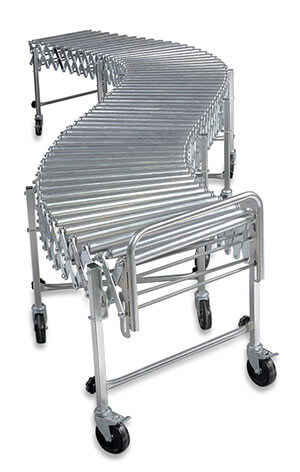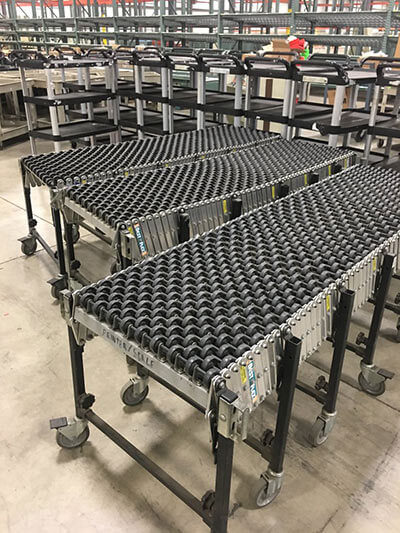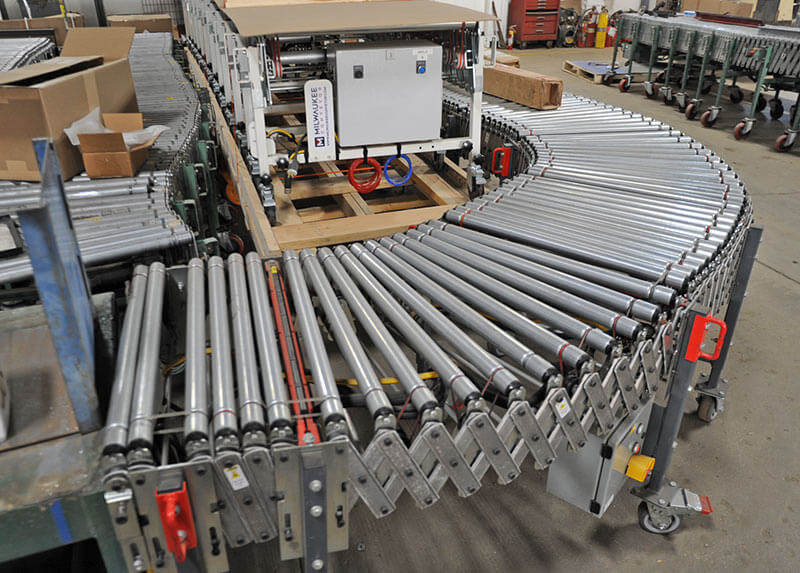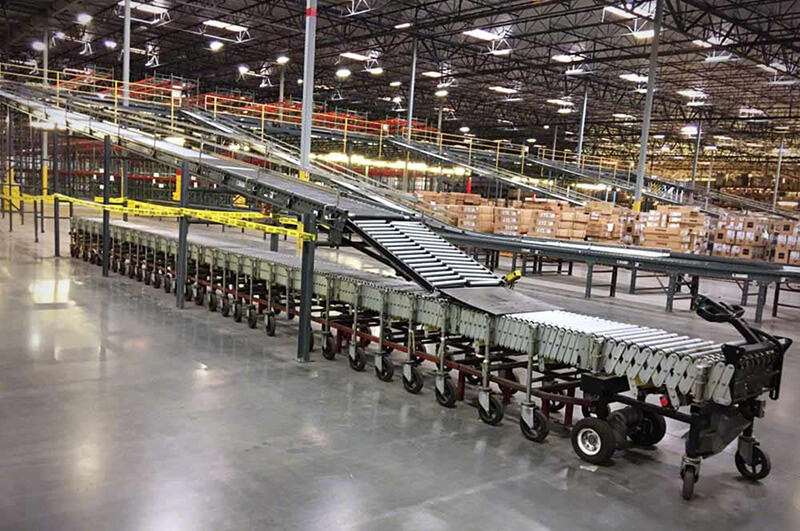In the ever-changing world of material handling, the search for more efficient and adaptable warehouse solutions has led to the emergence of a game-changing technology — flexible conveyors. This in-depth nine-part blog aims to explore the many benefits that come with using flexible conveyors, investigating how they can transform the way warehouses operate.
From understanding the basic principles of flexible conveyors to breaking down their key features, types, and applications, each part will uncover the potential these systems offer for making workflows smoother, optimizing space, and cutting down on operational costs.
As a leading material handling company, we at SJF Material Handling embark on this journey to shed light on the way toward a more flexible and efficient warehouse environment, showcasing how flexible conveyors lead the charge in bringing innovation to the dynamic world of logistics and material handling.
In the meantime, if you’re interested in seeing what we have available in both new and used conveyor systems, take a look at the following products. If you don’t see what you’re looking for, please contact us.
If you’d like to get a quote, check out our online quote request form.

Part 1. Understanding Flexible Conveyors
Part 2. Advantages Of Flexible Conveyors In Warehouse Operations
Part 3. Types Of Flexible Conveyor Systems
Part 4. Key Features Of Flexible Roller Conveyors
Part 5. Choosing The Right Flexible Conveyor System For Your Warehouse
Part 6. Installation And Maintenance Of Flexible Conveyor Systems
Part 7. Best Practices For Maximizing Efficiency With Flexible Conveyors
Part 8. Comparing Different Types Of Flexible Conveyor Belts
Part 9. Powered Flexible Conveyors: Benefits And Applications
Understanding Flexible Conveyors
In today’s fast-paced warehouse environments, the need for efficient material handling solutions has become increasingly critical. One such solution that has gained significant attention is the flexible conveyor.
Understanding the concept of flexible conveyors is essential for warehouse managers looking to streamline their operations and maximize productivity. Unlike traditional fixed conveyors, flexible conveyors are designed to be adaptable, allowing for easy reconfiguration and expansion to suit the evolving needs of a warehouse. This flexibility provides a range of benefits, including improved workflow, space optimization, and cost savings.
Flexible conveyors are characterized by their expandable and collapsible design, which enables them to be easily adjusted to fit the specific layout of a warehouse. This adaptability makes them well-suited for environments with limited space or those requiring frequent changes in layout. By utilizing flexible conveyors, warehouse managers can ensure a smooth and efficient flow of goods, ultimately enhancing overall productivity. Additionally, the ability to quickly reconfigure these conveyors allows for seamless integration with existing equipment, minimizing downtime and maximizing operational efficiency.
The versatility of flexible conveyors extends beyond their adaptability to different warehouse layouts. These systems are also capable of handling a wide variety of products, from small packages to larger items, making them a versatile solution for warehouses with diverse inventory requirements. This adaptability not only simplifies the material handling process but also contributes to improved order accuracy and customer satisfaction. Furthermore, the adjustable height and angle of flexible conveyors allow for ergonomic loading and unloading, reducing the risk of workplace injuries and promoting a safer working environment for warehouse staff.
Advantages Of Flexible Conveyors In Warehouse Operations
The implementation of flexible conveyors in warehouse operations offers a multitude of advantages that directly contribute to improved efficiency and productivity. One of the primary benefits is the ability to maximize space utilization within the warehouse. Unlike fixed conveyors that occupy a set footprint, flexible conveyors can be expanded or contracted as needed, effectively utilizing available space and accommodating changes in inventory volume. This adaptability not only optimizes storage capacity but also enhances the overall layout and organization of the warehouse, creating a more efficient and streamlined environment.
In addition to space optimization, flexible conveyors provide significant time and labor savings. Their adjustable design allows for quick and easy reconfiguration, reducing the time required for layout changes and equipment installation. This translates to minimized downtime and increased operational efficiency, as warehouse staff can swiftly adapt to fluctuating demands without disrupting ongoing processes. Furthermore, the flexibility of these conveyors enables seamless integration with other material handling equipment, such as packaging and sorting systems, further streamlining warehouse operations and enhancing overall productivity.
Another key advantage of flexible conveyors is their cost-effectiveness. By eliminating the need for extensive renovations or additional fixed conveyor systems, warehouses can significantly reduce their capital expenditure while still achieving efficient material handling capabilities.
The ability to expand or contract the conveyor length as needed also minimizes the requirement for excess equipment, resulting in reduced maintenance and operational costs. Additionally, the adaptability of flexible conveyors contributes to a more sustainable and environmentally friendly warehouse operation, as it promotes efficient resource utilization and minimizes waste.
Types Of Flexible Conveyor Systems

Flexible conveyor systems come in various configurations, each designed to address specific material handling requirements and operational challenges within a warehouse setting. Understanding the different types of flexible conveyor systems is essential for selecting the most suitable solution that aligns with the unique needs of a warehouse. One common type is the flexible roller conveyor, which utilizes a series of freely rotating rollers to convey goods along a predetermined path. This design offers smooth and efficient transportation of items, making it ideal for applications involving consistent product sizes and weights.
Another prevalent type of flexible conveyor system is the flexible skatewheel conveyor, which employs a series of rotating wheels to facilitate the movement of goods. This design is particularly well-suited for handling lightweight items and is known for its ease of maneuverability. Additionally, flexible skatewheel conveyors are often chosen for their cost-effectiveness and simple maintenance requirements, making them a popular choice for warehouses with diverse material handling needs.
Understanding the unique characteristics and capabilities of each type of flexible conveyor system is crucial for making an informed decision when implementing these solutions in a warehouse environment.
Key Features Of Flexible Roller Conveyors
Flexible roller conveyors, in particular, offer a range of key features that make them a valuable asset in warehouse operations. One of the primary advantages of flexible roller conveyors is their ability to handle a wide variety of products, including boxes, cartons, and totes, with ease. The freely rotating rollers provide smooth and consistent movement, ensuring gentle handling of goods and minimizing the risk of damage during transportation. This versatility makes flexible roller conveyors suitable for warehouses with diverse inventory profiles, enabling efficient and reliable material handling across different product types and sizes.
Another notable feature of flexible roller conveyors is their modular design, which allows for easy customization and expansion. By incorporating additional sections or accessories, warehouse managers can tailor the conveyor system to suit specific workflow requirements and accommodate future growth. This scalability ensures that the conveyor system can evolve alongside the changing needs of the warehouse, providing long-term flexibility and adaptability. Furthermore, the modular nature of flexible roller conveyors simplifies installation and reconfiguration, reducing the time and effort required to integrate these systems into the warehouse environment.
Additionally, flexible roller conveyors are designed for optimal ergonomics, promoting safe and efficient material handling practices. The adjustable height and angle of the conveyor system enable operators to load and unload goods with minimal strain, reducing the risk of workplace injuries and enhancing overall worker comfort. This ergonomic design not only contributes to a safer working environment but also enhances productivity by facilitating swift and hassle-free material transfer. The combination of versatility, modularity, and ergonomic functionality makes flexible roller conveyors a valuable asset in warehouse operations, supporting streamlined and efficient material handling processes.
Choosing The Right Flexible Conveyor System For Your Warehouse
Selecting the right flexible conveyor system for a warehouse requires a comprehensive assessment of operational needs, space constraints, and material handling requirements. Several factors should be considered when choosing a flexible conveyor system, including the type and volume of goods being handled, the layout of the warehouse, and the potential for future expansion. By evaluating these key considerations, warehouse managers can make informed decisions that align with their specific operational objectives and contribute to overall efficiency and productivity.
The first step in choosing the right flexible conveyor system is to assess the nature of the goods being transported within the warehouse. For warehouses with consistent product sizes and weights, a flexible roller conveyor may be the most suitable option, offering smooth and reliable movement of goods. Conversely, warehouses dealing with lightweight items or requiring enhanced maneuverability may benefit from a flexible skatewheel conveyor, which provides cost-effective and adaptable material handling capabilities. Understanding the unique characteristics and capabilities of each type of flexible conveyor system is crucial for making an informed decision that aligns with the specific needs of the warehouse.
Another crucial consideration when choosing a flexible conveyor system is the layout and available space within the warehouse. Assessing the dimensions and configuration of the facility is essential for determining the most effective placement and integration of the conveyor system. Flexible conveyors should be strategically positioned to optimize material flow, minimize congestion, and maximize space utilization. Additionally, consideration should be given to potential layout changes and expansion opportunities, ensuring that the chosen conveyor system can adapt to evolving warehouse requirements and support long-term operational efficiency.
Furthermore, the potential for future growth and scalability should be a key factor in selecting a flexible conveyor system. As warehouses evolve and expand, the material handling infrastructure must be capable of accommodating increased demand and changing operational dynamics. Choosing a flexible conveyor system that offers modular and scalable features allows for seamless adaptation to evolving requirements, minimizing the need for extensive equipment replacements or upgrades. This long-term flexibility ensures that the chosen conveyor system can continue to support warehouse operations as they grow and evolve, contributing to sustained efficiency and productivity.
Installation And Maintenance Of Flexible Conveyor Systems
Once the appropriate flexible conveyor system has been selected for a warehouse, proper installation and ongoing maintenance are essential to ensure optimal performance and longevity. Proper installation of flexible conveyor systems involves careful consideration of layout, configuration, and integration with existing material handling equipment. This process requires attention to detail and adherence to manufacturer guidelines to guarantee safe and effective operation within the warehouse environment. Additionally, regular maintenance and upkeep are crucial for preserving the functionality and reliability of flexible conveyor systems, extending their service life and minimizing the risk of operational disruptions.
During the installation of flexible conveyor systems, warehouse managers should prioritize the alignment of the conveyors with the workflow and material handling requirements of the facility. This involves positioning the conveyors to facilitate efficient product flow, minimize congestion, and optimize space utilization. Proper alignment and integration with other material handling equipment, such as sorting and packaging systems, are essential for seamless operation and overall warehouse productivity. Adhering to installation best practices ensures that the flexible conveyor system is fully optimized to support the specific operational needs of the warehouse.
In addition to installation, ongoing maintenance is critical for preserving the performance and reliability of flexible conveyor systems. Regular inspections of the conveyor components, such as rollers, belts, and drive systems, are necessary to identify and address any signs of wear, damage, or malfunction. Scheduled cleaning and lubrication of the conveyor elements help prevent debris buildup and ensure smooth operation. Furthermore, proactive maintenance practices, such as routine belt tension adjustments and motor checks, contribute to the overall longevity and efficiency of the conveyor system. By prioritizing regular maintenance, warehouse managers can mitigate the risk of unexpected downtime and maximize the operational lifespan of their flexible conveyor systems.

Best Practices For Maximizing Efficiency With Flexible Conveyors
Incorporating best practices for utilizing flexible conveyors is essential for maximizing efficiency and productivity within a warehouse environment. By following industry-recommended guidelines and operational strategies, warehouse managers can optimize the performance of flexible conveyor systems, streamline material handling processes, and achieve long-term operational success. Implementing best practices involves a holistic approach that encompasses system configuration, workflow optimization, and employee training, ultimately contributing to enhanced efficiency and overall warehouse productivity.
One of the fundamental best practices for maximizing efficiency with flexible conveyors is to conduct a thorough assessment of material flow and operational requirements within the warehouse. This involves analyzing the specific needs of the facility, including product types, volumes, and handling processes, to determine the most effective configuration and utilization of the conveyor system. By aligning the layout and functionality of flexible conveyors with the unique operational dynamics of the warehouse, managers can optimize material flow, minimize bottlenecks, and enhance overall productivity. This comprehensive assessment serves as a foundation for implementing tailored solutions that address the specific efficiency goals of the warehouse.
Furthermore, optimizing the workflow and material handling processes around flexible conveyors is essential for maximizing efficiency. This includes strategically positioning the conveyors to facilitate seamless product transfer, minimize manual handling, and optimize space utilization. Implementing efficient loading and unloading procedures, such as utilizing gravity flow or automated transfer systems, helps streamline material flow and minimize unnecessary handling steps. Additionally, integrating flexible conveyors with automated sorting and packaging equipment further enhances operational efficiency and contributes to the overall productivity of the warehouse. By optimizing workflow and material handling practices around flexible conveyors, warehouse managers can achieve significant efficiency gains and operational improvements.
Employee training and engagement are also crucial components of maximizing efficiency with flexible conveyors. Providing comprehensive training programs that familiarize warehouse staff with the proper operation, maintenance, and safety protocols of flexible conveyor systems ensures reliable and consistent performance. Additionally, involving employees in process improvement initiatives and encouraging feedback on system usability can lead to valuable insights for optimizing conveyor utilization and material handling practices. By fostering a culture of continuous improvement and operational excellence, warehouse managers can empower their workforce to contribute to the ongoing efficiency and productivity of the warehouse.
Comparing Different Types Of Flexible Conveyor Belts
Flexible conveyor belts play a pivotal role in the efficient movement of goods within a warehouse, and understanding the different types of conveyor belts is essential for selecting the most suitable solution for specific material handling requirements. Various types of flexible conveyor belts offer unique features, capabilities, and performance characteristics, each catering to distinct operational needs and product handling challenges. By comparing different types of flexible conveyor belts, warehouse managers can make informed decisions that align with their specific efficiency goals and contribute to enhanced productivity within the facility.
One common type of flexible conveyor belt is the flat belt, which offers a smooth and consistent surface for conveying goods. Flat belts are well-suited for handling a wide range of products, from small packages to larger items, and are known for their reliable performance and versatility. The flat surface of these belts ensures stable and secure transportation of goods, minimizing the risk of product damage and promoting efficient material flow within the warehouse. Additionally, flat belts are compatible with various drive systems and accessories, allowing for flexible integration with different material handling equipment.
Another prevalent type of flexible conveyor belt is the modular belt, which is characterized by interlocking plastic modules that form a continuous conveying surface. Modular belts are known for their robust construction, high load-bearing capacity, and easy maintenance, making them suitable for handling heavy or irregularly shaped products. The modular design of these belts allows for easy customization and reconfiguration, enabling warehouse managers to adapt the conveyor system to changing operational requirements and product handling challenges. Furthermore, modular belts offer enhanced flexibility and durability, contributing to reliable and efficient material handling within the warehouse.
Comparing different types of flexible conveyor belts also involves evaluating specialty belts designed for specific material handling applications. For example, friction-top belts are equipped with a textured surface that provides additional grip for inclined or declined conveying, making them ideal for handling products on an incline or decline. Similarly, vacuum belts utilize suction to securely hold and convey lightweight or delicate items, ensuring gentle and precise handling during transportation. Understanding the unique features and capabilities of specialty conveyor belts is essential for identifying the most suitable solution for specific product handling challenges within the warehouse.
Powered Flexible Conveyors: Benefits And Applications
Powered flexible conveyors, which utilize motorized drive systems to facilitate material movement, offer a range of benefits and applications that contribute to enhanced efficiency and productivity within warehouse operations.
Understanding the advantages and potential applications of powered flexible conveyors is essential for warehouse managers looking to optimize material handling processes and achieve operational excellence. From increased throughput and reduced labor requirements to versatile product handling capabilities, powered flexible conveyors offer a valuable solution for streamlining warehouse operations and maximizing overall productivity.
One of the primary benefits of powered flexible conveyors is their ability to significantly increase throughput and operational efficiency within a warehouse. By automating the movement of goods, powered conveyors minimize manual handling and facilitate rapid and consistent product flow. This results in reduced cycle times, optimized order fulfillment, and enhanced overall productivity.
Additionally, powered flexible conveyors can be seamlessly integrated with sorting and packaging systems, further streamlining material handling processes and contributing to improved accuracy in order processing. The seamless integration with sorting and packaging systems enhances the overall material handling ecosystem, ensuring a synchronized and efficient workflow.
This integration allows for a more systematic approach to inventory management, as goods move seamlessly from one stage to another, reducing bottlenecks and potential errors. The collaborative operation between powered flexible conveyors and sorting/packaging systems not only expedites the order fulfillment process but also contributes to a higher level of precision in packaging, minimizing the likelihood of errors or damages during transit.
As a result, the warehouse can achieve improved order accuracy and customer satisfaction, reinforcing the role of powered flexible conveyors as a cornerstone in the quest for operational excellence within the dynamic landscape of modern material handling.

